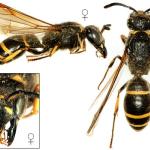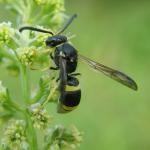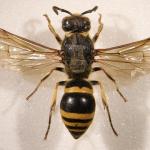Identification keys and general biology are given in Krombein (1967), Spradbery (1973), Richards (1980), Yeo & Corbet (1995) and Archer (2000).
Cornwall to Kent, north to Cumbria and Northumberland (Longbenton), Wales, Isle of Wight and the Channel Islands (Guernsey). There is also a record from Scotland, “near Hilliesland, Roxburghshire” during 1882, but the grid reference for this locality is unknown.
Overseas, found throughout Europe (including Norway, Sweden, Finland, Denmark, The Netherlands, Belgium, Luxembourg, France, Spain, Germany, Italy, Poland, Greece and european Russia), north Africa, Turkey, across asiatic Russia to the far eastern regions, Mongolia, China (Manchuria), Japan and North America.
Listed as Rare (RDB3) in Shirt (1987) and Falk (1991). This species has shown a recent significant decline.
Found in a wide variety of habitats associated with its nesting and feeding sites and prey habitats.
Univoltine; most likely to be seen during June and July, less frequently in May and rarely in August and September.
Usually small lepidopterous caterpillars from several families, for example, Pyralidae and Gelechiidae, and more rarely beetle and sawfly larvae.
A tube-dweller, usually in bramble and elder stems, forming a series of linear cells separated by clay partitions. Also nests in holes in wood, old mortar walls and in the cavity of a window frame of a commuter train, even though the train made several journeys each day. After an egg is laid, several paralysed caterpillars are forced into the cell. The egg hatches after a few days and the larva consumes the prey in one or two weeks. The larva spins a cocoon and enters winter diapause as a pre-pupa.
Michaelmas-daisy, dwarf elder, privet, sea-holly, spurge and a thistle.
Morgan (1984) gives the chrysidid wasps Chrysis pseudobrevitarsis Linsenmaier and C. longula Abeille de Perrin. The mite Kennethiella trisetosa feeds on the pupal stage without causing death. On the emergence of the adult wasp the mites, which are mainly on the males, cling to the propodeum before moving into the genital chamber. During copulation the mites are passed to the females.
2001




